Thanks for your support! If you make a purchase using our links in this article, we may make a commission. And, as an Amazon Associate, I earn from qualifying purchases. See the full disclosure here.
Updated April 2, 2024
Recreational Vehicles come in many shapes and sizes. They range in size from a small teardrop trailer that can be pulled by a motorcycle to a gigantic house on wheels with a king-sized bed, granite countertops, and a fireplace in the living room! And if you’re new to RVing, understanding RV classes and types can be really confusing and overwhelming.
If you’ve read our blog articles or seen us on YouTube, you know we have toured and reviewed hundreds of RVs a year for the past five years.
In this article, we’re diving deep into every type and class of RV to help you better understand and differentiate between them. This will help you recognize RV classes on the road and better understand if you’re hoping to buy one!
What Are RV Classes?
RV Classes are classifications used to describe the different types of drivable RVs. Class A motorhomes are large and built on a truck chassis. Class B RVs are built on a van chassis. And Class C RVs are built on a large pickup truck chassis with a cabover section above the cab.
When choosing between the different classes of RVs or Motorhomes, it’s beneficial to understand what RV classes are and how they are different. It’s also helpful to know each type’s amenities, costs, drivability, and pros and cons.
Towable RVs don’t have designated classes. Instead, towable RVs are trailers. And yes, there are different types of RV trailers.
Travel trailers are RV trailers that hook up to the bumper of a vehicle. Sometimes called bumper pulls, travel trailers can be towed with any vehicle as long as it has the towing power.
Fifth wheels are the largest type of towable RV. They attach via a hitch in the bed of a pickup truck, so they can only be towed by trucks.
Alternative RV Types
There are alternative RV types like camper van conversions and school bus conversions that are also helpful to know.
While RVs that are built on a van chassis are called Class B RVs, DIY and self-built van conversions would not be classified as such. Instead, DIY campervans are just called camper vans.
School bus conversions are known as Skoolies. There are four different school bus classes, A through D, which we will cover in this article too.
You can also check out our YouTube Video called 11 RV Types and Styles.
If you are thinking about buying an RV we highly recommend renting one before you buy one to see of you like it.
Susan and I rented a Class C RV before we bought ours which educated us enough to purchase the perfect RV for us. We learned everything we liked and didn’t like about our rental and we made sure the Class C we bought had the floor plan and features we wanted.
3 Motorhome RV Classes
Let’s take a look at the 3 types of drivable RVs and their classes.
1. Class A
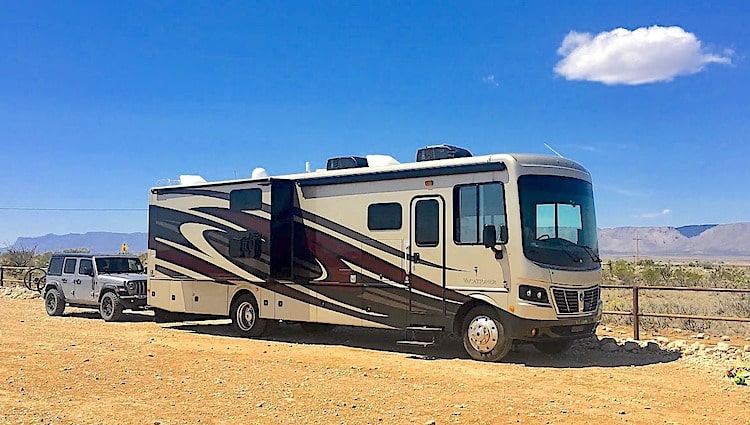
A Class A motorhome is the biggest of the drivable RV classes. They look like a big commercial bus with fewer windows, a fancier paint job and antennae on the roof. These motorhomes are the most luxurious of all the classes.
They range in size from 25 to 45 feet or more, and some can sleep up to eight or ten passengers. Since these motorhomes are so big and heavy, they are the least fuel efficient with some getting as little as five or six miles a gallon.
Class A Motorhomes are great for folks who spend a lot of time on the road. They are like having your home on wheels and include features such as a king-sized bed, two or more bathrooms, a full-sized refrigerator, and a washer and dryer. Since these motorhomes are built on a commercial truck chassis, there is plenty of space underneath for storage.
Many Class A motorhomes have 3 to 4 slideouts, making the space inside even larger. You can expand a typical Class A RV from 8 feet to 13 feet wide if the slideouts are across each other.
Class A Motorhomes have either gasoline or diesel-fueled engines, which are known as pushers or pullers. A pusher, or diesel pusher, means that the engine is in the back, and so the driving cab is cooler and quieter.
It is also built with a larger engine on a heavier chassis, can handle a massive load, and can tow more. In a puller, the engine is in the front, which allows better floor plan options because the engine is under the front end.
Class A Motorhomes Are Great for Full-Timing
We own a Class A motorhome, and we feel that Class A motorhomes are great for full-time travel. They are the most expensive of the classes but the convenience and comfort they provide are perfect for folks who are on the road for long road trips.
These RVs can’t go everywhere, though. They are meant to stay on paved roads that are wide and in good condition. Therefore, some campgrounds and or campsites may be inaccessible.
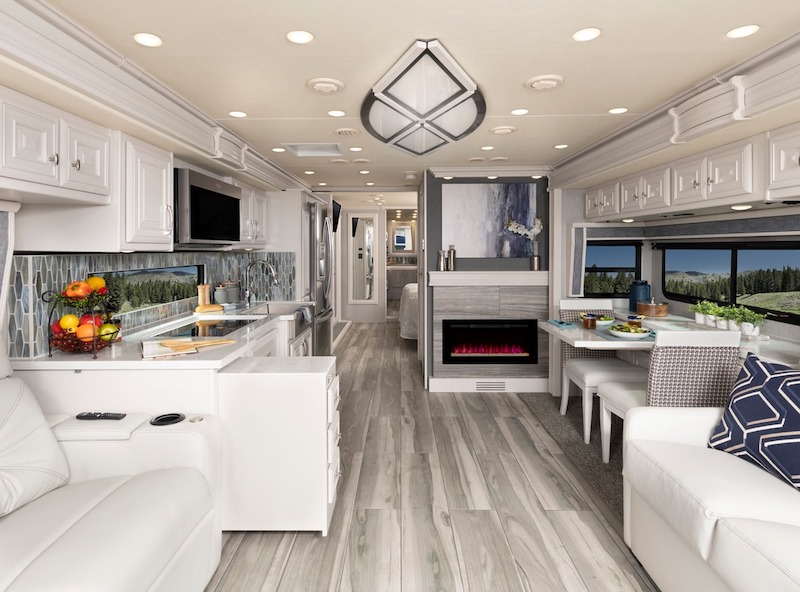
Also, once you get set up at a campsite, it’s not convenient to leave again to run errands or go sightseeing. Many Class A RVers like us choose to tow along a vehicle to get around.
In addition to the initial expense of the RV, the costs of repairs, insurance, and fuel are also the highest of any other motorhome.
Class A motorhomes range in price from as low as $125,000 to over $600,000. There are many amenities that can add to the price of a Class A RV, such as engine type, engine location, electronics, interior finishes, and much more.
✅ Pros of Class A RVs
- Large interior living spaces
- Many options and luxury amenities
- Plenty of cargo storage
⛔️ Cons of Class A RVs
- It can be difficult to drive
- Need a second vehicle to see the surrounding area
- Expensive to purchase, repair, operate, and insure, Class A motorhomes may be impractical for many. However, they are perfect for extended or full-time road trips. They are very popular with retirees and those living on the road full-time.
Class B RVs
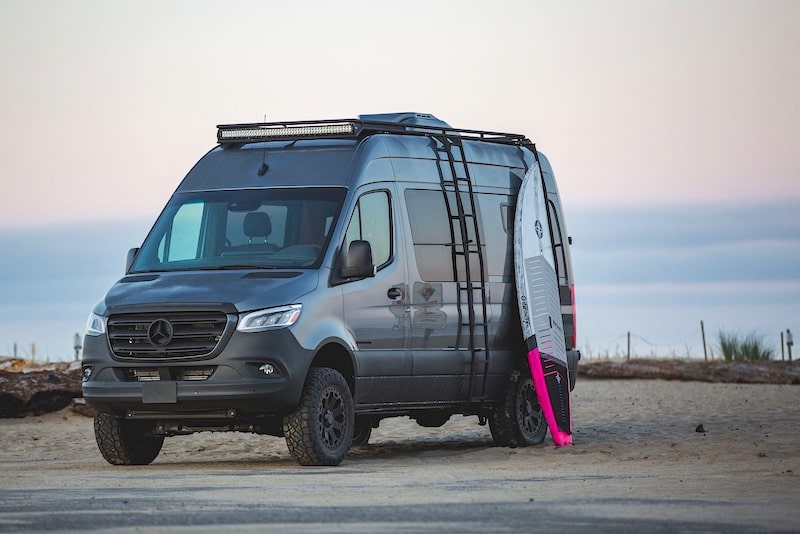
Class B motorhomes are also known as camper vans. These RVs are the smallest of the RV classes. They are easy to drive and since they are smaller and lighter they can go many places that the RV Classes A and C motorhomes cannot reach. Although they are more mobile than the other classes, they have much less room inside.
Class B RVs have a small kitchen, bathroom, and sleeping area but everything about a Class B is designed to use as little space as possible. Since these RVs are smaller, they get better gas mileage than the other RV classes. Some are even 4 wheel drive so you can reach the beach, go off road and boondock or just trek to the best campsites.
What Class B motorhomes sacrifice in spaciousness they make up for with convenience and economy. Class B RVs fit in regular parking spaces, are fuel efficient, and you don’t need a separate vehicle to run errands or sightsee.
They are also easy to drive since they are the size of a large van. And they do not require a special license to drive them. The price for a Class B RV ranges from $100,000 up to $275,000.
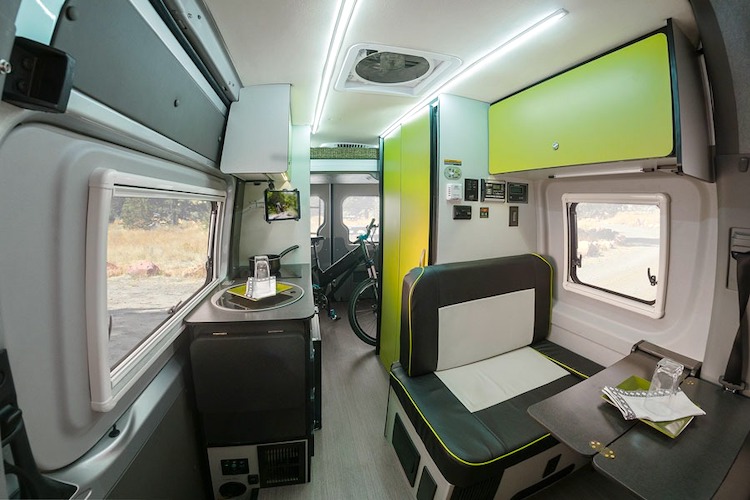
These RVs are perfect for one or two travelers who are on the go and like to live a minimalist lifestyle, staying outside of the vehicle most of the time. I don’t think living in a Class B with children is a sustainable lifestyle.
There are several other pros and cons to consider when it comes to Class B motorhomes:
✅ Pros of Class B RVs
- Lower Cost
- Better Gas Mileage
- Great Mobility
⛔️ Cons of Class B RVs
- Very little storage space
- Minimalist features such as a small bathroom, kitchen, and living area
- Can only accommodate one or two people
Class C RVs

Class C RVs are midsized RVs that range from 19 to 36 feet long. They are easily recognizable because of the bunk area that extends out over the top of the driving cab. Class C RVs have many of the same amenities as Class A RVs but at a lower price point.
We also own a Class C RV, and we can tell you they offer more living space than the confining Class B motorhomes with many of the same amenities as the Class A RVs.
They have a bathroom, an adequate kitchen, and plenty of places to sleep. Some of the larger models feature a master bedroom suite in the rear while most others have a queen-sized bed toward the rear of the RV.
Couches and dinette tables convert into beds and the overhead compartment above the cab can be used for storage or additional sleeping quarters.
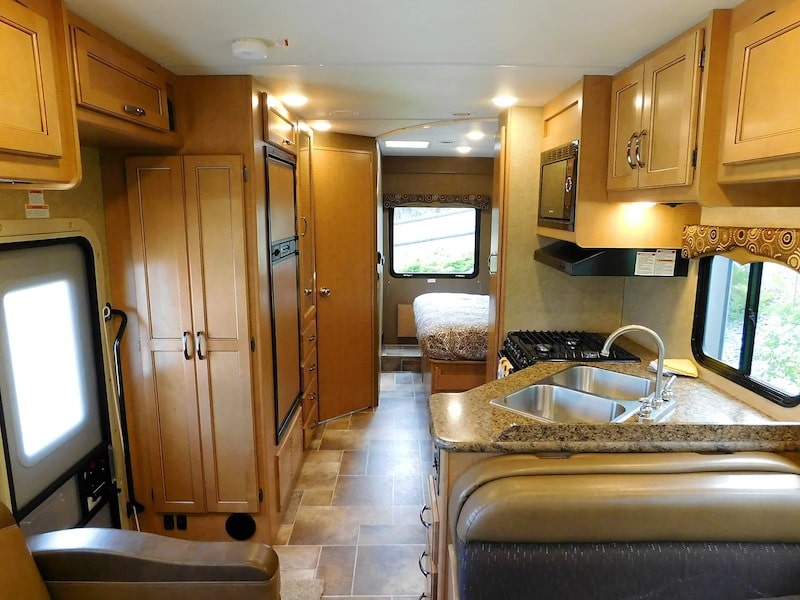
Class C motorhomes can be every bit as challenging to drive as Class A motorhomes, but they are usually easier to manage in restricted campsites. Travelers can also tow a separate vehicle for sightseeing and errands.
The fuel costs are slightly better, as are the maintenance and insurance; however, these are still relatively expensive to operate when compared to class B RVs. Class C RVs range in price from $60,000 to $200,000.
Other Types of Class C Motorhomes
There are two other types of Class C RVs, however. One type is a compact Class C RV and the other is a C+RV, also called a Super C Motorhome.
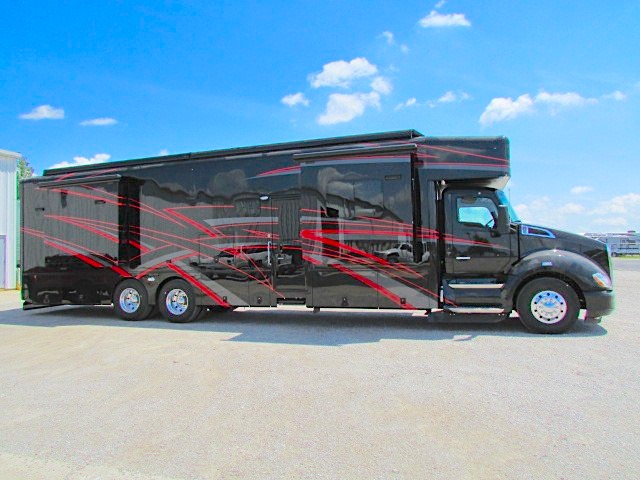
Compact Class C RVs
Compact Class C RVs are under 22 feet long yet contain most of the features of a larger Class C RV. Because of their smaller size, they are much easier to drive and they can handle tighter turns on curvy mountain roads since their wheelbase is shorter.
They can also go where larger RVs can’t. For example, they can travel into certain National Parks where the maximum RV length is only twenty feet.
Compact Class C RVs can sleep up to four people. Two adults can comfortably sleep over the cab, and two kids can sleep on the dinette that converts into a bed. Most come with a full kitchen, including a sink, fridge, range, and convection microwave oven.
Although they do come with a full bath, it is usually a “wet bath,” which means that the shower, sink, and toilet are all in one room. Also, compact RVs don’t have much storage space.
Compact RVs are great for minimalists who need a little more space than a Class B RV. They are also a great choice to rent if you are RVing for the first time.
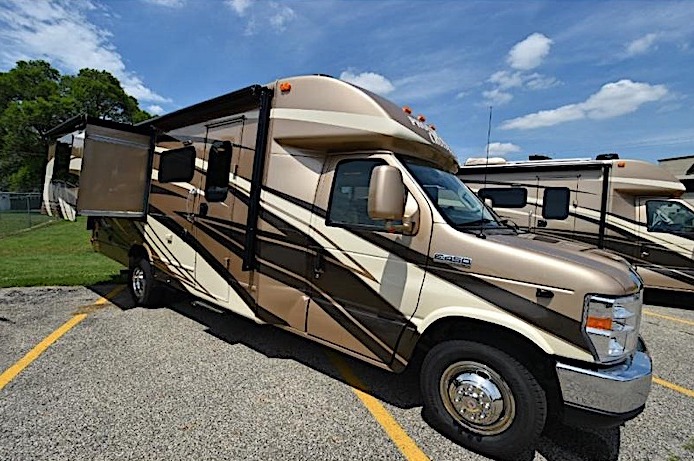
C+ or Super C RVs
C+ or Super C RVs are the exact opposite of Compact RVs. They are big, luxurious Class C RVs that compete against the larger Class A RVs. Many of these Super C RVs have diesel engines that can also pull a tow car behind them.
They look like the front end of an eighteen-wheeler truck combined with the body of a Class C RV. They are also designed for extended trips and full-time RVers. These RVs come with many of the features found in Class A RVs but at a lower cost.
They don’t have as much storage space as Class A RVs, but like the Class A, you will probably need a tow car since they are big and inconvenient for running errands or sightseeing.
As with the Class A and Class B motorhomes, Class C motorhomes have their pros and cons:
✅ Pros of Class C RVs
- They are spacious yet economical
- Maximize sleeping space
- Better fuel efficiency than Class A RVs
⛔️ Cons of Class C RVs
- They have limited towing capacity
- Storage space is small
- The larger ones can be difficult to drive
RELATED READING: Check out our article Class A vs Class C RV and How to Decide Which is Best to understand all the differences between a Class A and Class C Motorhome.
Truck Campers
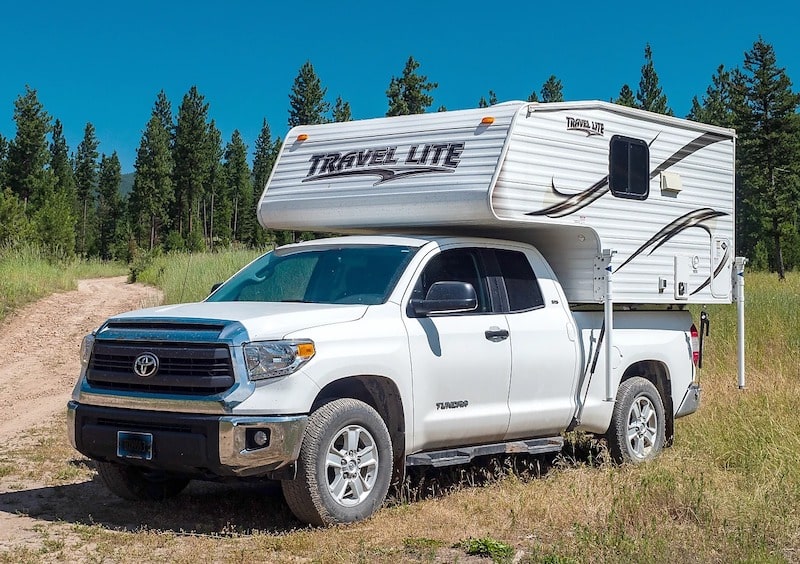
A Truck Camper doesn’t fit into any of the above mentioned categories. Truck campers are loaded directly onto the bed of a pickup truck and then secured in place. They range in length from 18 to 21 feet and can sleep 2 to 4 people.
The great thing about truck campers is if your pickup truck is 4-wheel drive, you can go anywhere and boondock.
For example, you can drive out onto the beach and camp or get to very remote destinations where other RVs just can’t go. And it’s much cheaper to buy a truck camper than it is to convert your Class C RV to 4 wheel drive. They can drive over any type of terrain the truck can handle and cost between $30,000-$100,000.
Believe it or not, truck campers can come with bathrooms. Some have no bathroom, others are equipped with potty storage, and the upper-end campers can have a full bath. Slide-outs are also available on some models, but this will increase the truck camper’s weight and price.
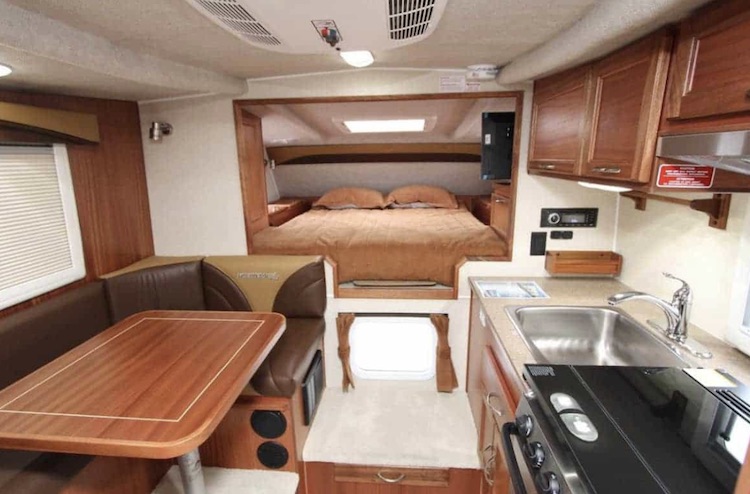
Some folks buy a truck camper and plan to tow an ATV or boat behind it. Just take into account that the truck camper may hang past your bumper hitch, preventing you from towing anything.
Types of Trucks That Can Carry Truck Campers
There are 6 major full-size truck manufacturers with models that are capable of carrying campers. They are:
- Chevy Silverado
- GMC Sierra
- Dodge Ram
- Ford F-Series
- Toyota Tundra
- Nissan Titan
✅ Pros of Truck Campers
- They can go where other RVs can’t go
- They are very inexpensive – especially if you already own a pickup truck large enough to handle the camper
- Easy to store since they are smaller
⛔️ Cons of Truck Campers
- Minimal amenities compared to other RVs
- If you overload the camper, the pickup truck suspension may suffer
- Very limited storage space
RELATED READING: Check out our article 7 Awesome Reasons to Buy a Flatbed Truck Camper. Not many people consider this option but it’s roomier that a standard truck camper.
Skoolies
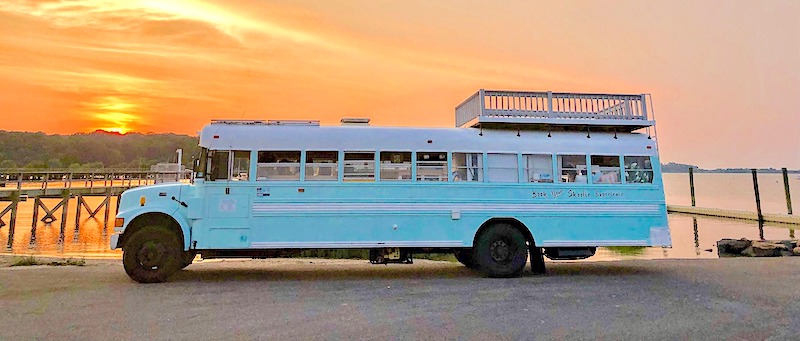
The picture above is from SmartCampervan.com and shows the level of luxury that can be attained in a school bus conversion.
Another type of RV that has become more popular recently is the school bus conversion known as a skoolie. These are drivable RVs that aren’t Class A, B, or C. The most significant advantage of a skoolie is that it is wide open in the back, and if you are creative and enjoy remodeling, you can design your skoolie just the way you want.
The drawback of a skoolie is that it needs to be remodeled before you can go RVing with it. They can also be hard to drive, and they bounce a lot. There is also a significant amount of tail swing since the back of the school bus is so far behind the back wheels.
There are four types of school buses on the road. School buses have classes all their own.
TYPE A School Bus
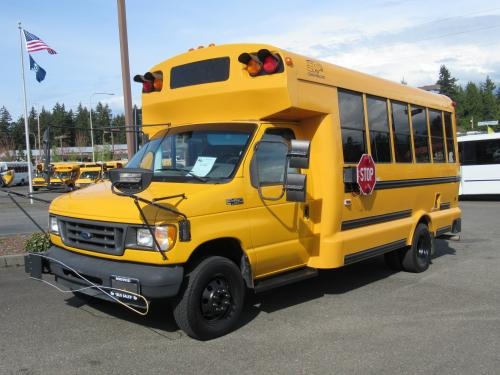
A Type “A” school bus is a van conversion or bus constructed utilizing the front section of a truck, which includes the left-side driver’s door. It’s also known as a short bus. The engine compartment is in front of the driver’s cab.
The type A bus includes two classifications: Type A-I, with a Gross Vehicle Weight Rating (GVWR) less than or equal to 14,500 pounds, and Type A-II, with a GVWR higher than 14,500 pounds and less than or equal to 21,500 pounds.
TYPE B School Buses
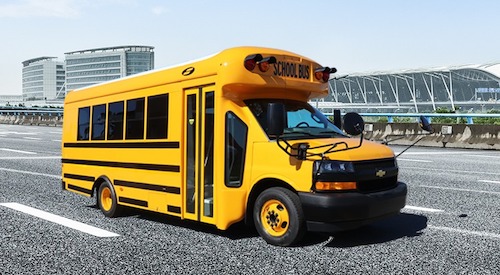
A “type B school bus” is a conversion or body constructed and installed upon a van, front-section vehicle chassis, or stripped frame without a driver’s side door.
Its gross vehicle weight rating is more than 10,000 pounds, and it’s designed for carrying more than ten people. Part of the engine is beneath or behind the windshield and beside the driver’s seat. The entrance door is behind the front wheels.
TYPE C School Bus

A Type “C” school bus is constructed utilizing a chassis with a hood and front fender assembly. The engine is in front of the driver, and the entrance door is behind the front wheels.
A “type C school bus” also includes a cutaway truck chassis or truck chassis with a cab, with or without a left side door, and with a GVWR higher than 21,500 pounds.
TYPE D School Buses

A “type D school bus” is a body installed upon a chassis, with the engine mounted in the front, midship or rear. It has a gross vehicle weight rating of more than 10,000 and is designed for carrying more than ten persons.
The engine may be behind the windshield, beside the driver’s seat, at the rear of the bus, behind the rear wheels, or midship between the front and rear axles. The entrance door is ahead of the front wheels. A type D school bus is the largest type and has a maximum length of 45 feet.
Towable RV Types Explained
Now that we have covered the drivable RVs let’s dive into the towable RV types. Towable RVs are not designated by RV classes, but sometimes you will hear people refer to their respective “class” as a travel trailer, 5th wheel, etc.
5th Wheel RV
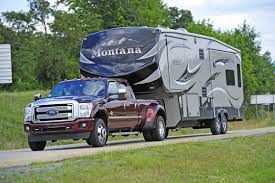
A fifth wheel is a towable RV that connects to a hitch inside the bed of a pickup truck. The hitch, which is called a jaw hitch, is located directly above the rear axle of the pickup truck.
The location of the hitch is vital because it allows about 15 to 25% of the weight of the 5th wheel to be supported by the rear axle of the pickup truck. Since some of the weight of the 5th wheel can be transferred to the pickup truck, it’s possible to build huge 5th wheels to maximize living and storage space.
For RVers looking to get the most bang for their buck, a 5th wheel is a great choice. 5th wheels are spacious inside and the floor plans are the best of all the RVs. If you are looking to get a recreational vehicle with more space for living and storage, then a fifth wheel offers the most square footage for your needs. Fifth wheels can range in price from $50,000 to $140,000.
While it is easier to tow a 5th wheel than all the other types of towable RVs you must have a pickup truck with enough horsepower and towing capacity to haul it. Very often, purchasers of 5th wheels also have to buy a new pickup truck, which can make purchasing a 5th wheel an expensive proposition. However, once you set up the 5th wheel at your campsite, you will have a vehicle to explore the get around.
✅ Pros of 5th Wheel RVs
- The tow vehicle doubles as local transportation
- More comfortable and safer to tow than a travel trailer
- 5th wheels are easier to back up than travel trailers
- They offer the best floor plans
⛔️ Cons of Fifth Wheel RVs
- Needs a pickup truck with a special hitch in the bed
- 5th wheel height creates problems for going under overpasses or trees
- Requires a large pickup truck to tow it
- Larger models can be challenging to maneuver in tight spaces.
RELATED READING: Very often RV purchasers find themselves weighing the pros and cons of a 5th wheel versus a class C RV. Check out our article called Class C RV vs 5th Wheel – Which is Better and Why?for a detailed look at this question.
Travel Trailers (aka Bumper Pull RVs)
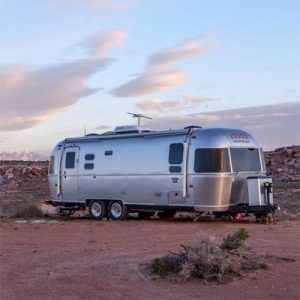
Travel trailers, also known as travel campers or camper trailers, are RVs pulled by another vehicle’s bumper. They range in size from tiny teardrop trailers to massive trailers up to 40 feet with slideouts.
Travel trailers are constructed on top of a standard trailer frame and are equipped with many amenities. They can be pulled by any number of vehicles since they are pretty light for their size.
These RVs connect with a standard ball hitch receiver. Sway bars can be installed for more stability. They can be pulled by any truck, van, or SUV that is rated to handle the weight capacity.
One of the main advantages of a travel trailer is its low cost. Compared to fifth wheels, they are much less expensive, and you don’t have to buy a new tow vehicle with a very high tow capacity. Travel trailers are very economical, and with the addition of a front sway bar, they are safer than ever to tow behind you.
On the downside, driving while towing a travel trailer can be difficult and will take some practice. Backing up with a trailer is extremely difficult, and turning it is difficult, too. The tail swing can be an issue for trailers with extended living quarters in the back.
And you need to make sure you don’t overload the travel trailer or it may be too heavy to tow safely. Also, you will need to keep your trailer level while camping and when you store it.
RELATED READING: Check out our article, 10 Most Googled Travel Trailer Camping Questions for some great info.
✅ Pros of Travel Trailers
- A travel trailer is less expensive than other RVs
- Once you set up camp you can use your tow vehicle to drive around
- Travel trailers can be towed by a wide variety of vehicles
⛔️ Cons of Travel Trailers
- Very difficult to drive in reverse
- Driver must be aware of turning short and tail swing
- Leveling your travel trailer can be a challenge
Folding Trailer or Pop-Up Camper
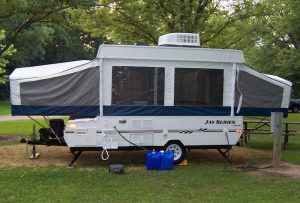
The folding trailer, also known as a popup trailer, tent trailer or tent camper, is a small, lightweight, towable trailer that folds or collapses into a smaller, more aerodynamic size.
There are three types of folding trailers: hard-side popup trailers, tent campers, and telescoping or hi-lo popup trailers. It’s amazing how many designs there are.
But the folding trailer’s small size, light weight, and low cost make it a trendy option for budget-conscious campers towing behind light vehicles such as cars, SUVs, and mini pickup trucks. Some of the smallest models can even be pulled behind large motorcycles.
Due to the nature of these designs, it is difficult to store anything in them. Supplies and equipment must be carried separately. The folding joints and canvas sections can wear out and may eventually develop leaks.
And tent-style trailers expose occupants to more of the elements. Other basic necessities, like toilets and kitchen facilities, are often minimal or not present at all.
✅ Pros of Popup Campers
- Popups are very lightweight and can be towed behind smaller vehicles such as small trucks, SUV’s, vans, cars, and even motorcycles
- Popups are one of the least expensive RVs
- The tow vehicle doubles as local transportation
- No height clearance issues because they fold down
- Sleeping in a popup is also like sleeping in a tent
⛔️ Cons of Popup Campers
- They have limited space and amenities
- They are difficult to set up (Susan owned a popup camper and sold it after one season)
- It’s difficult to store things in a popup, and you can’t access anything until the popup is set up.
- Popups don’t last as long as other RVs
- Sleeping in a popup is like sleeping in a tent (it could go either way)
RELATED READING: Check out our article What You Should Know Before Buying a Pop Up Camper before you buy a Popup Camper!
Toy Hauler Trailers
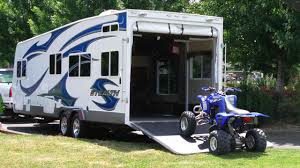
Toy Haulers are travel trailers or fifth wheels with a garage in the back so you can bring along a large “toy” such as a motorcycle, ATV, or snowmobile. They combine the features of a travel trailer or fifth wheel and a sports utility trailer.
The garage area is used for storing sports vehicles, and most have floor-mounted D-rings for securing your Toys. They also have a folding rear wall that doubles as a loading ramp. The front of the toy hauler is set up with a living space like you would find in any travel trailer.
Toy haulers range in length from 25 to 40 feet or more and can sleep anywhere from 2 to 8 people. Depending on size and amenities, you can find toy haulers that range in price from $55,000 to $125,000. For RVers who enjoy motorsports, a travel trailer or 5th wheel that combines living quarters and a garage is perfect.
✅ Pros of Toy Haulers
- The toy hauler is multifunctional
- You can outfit the garage portion for toys or even a workshop
- It has all of the conveniences of a travel trailer or 5th wheel
⛔️ Cons of Toy Haulers
- The smell of oil and gas can enter the living area
- You sacrifice living space for garage space
Related Questions
1. Should I buy or rent an RV?
If you are new to RVing, you may want to consider renting an RV before you buy one. I cover all of the details about owning an RV in my article called The Pros and Cons of Owning an RV if you want more info.
But the bottom line is that renting an RV before buying one is definitely better. Especially if you’re trying to decide between the RV classes. This will allow you to see what you like and don’t like about an RV so you can make a better-informed decision before purchasing your new RV. If you plan to rent an RV, Outdoorsy is a great place to find the RV of your choice to rent.
RELATED READING: Check out our article called The Ultimate Guide to Renting an RV for tons of great info about how and where to rent an RV.
2. What other equipment or supplies will I need if I buy or rent an RV?
Not everything you need is included when you rent or buy an RV. So, you will need lots of RV Camping equipment and gear. But some equipment is essential and other stuff is not that important. Check out our article 21 Must Have RV Accessories for a New Camper or Travel Trailer so you will know exactly what gear you need to have a successful RV camping trip.
What is your favorite type of RV and why? Please share your thoughts with us in the comments below!
Learn More!
– Single vs Dual Axle Camper Trailers: Which Are Best?
– 10 Best RVs and Campers for Beginners in 2024
– Gas vs. Diesel RVs – Which Motorhome is Best?
– Class A vs Class C Motorhome and How to Choose
– Fifth Wheel vs Class A Motorhome – Pros and Cons to Help You Choose Before You Buy
To see a list of all of our articles check out the Blog Archive!
If you would like to contact us directly, please feel free to visit our Contact Page and send us an email.
Mike Scarpignato – Bio
Mike Scarpignato created RVBlogger.com over five years ago in 2018 to share all we have learned about RV camping.
Mike is an avid outdoorsman with decades of experience tent camping and traveling in his 2008 Gulf Stream Conquest Class C RV and 2021 Thor Challenger Class A motorhome.
We attend RV Shows and visit RV dealerships all across the country to tour and review drivable motorhomes and towable trailers to provide the best evaluations of these RVs in our blog articles and YouTube videos.
We are 3/4-time RVers who created RVBlogger.com to provide helpful information about all kinds of RVs and related products, gear, camping memberships, tips, hacks and advice.


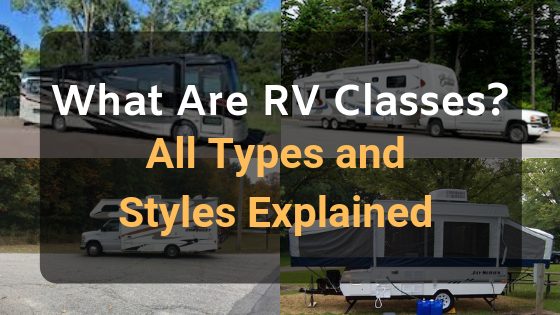

I’m glad to see that RV classes are becoming more popular. This is a great way to learn about different RV types and styles.
You forgot about Campulances!
thank you
This brief video was extremely informative and entertaining. I am contemplating selling my house and moving into a travel trailer in the near future. I thought I knew what I needed until I watched your presentation. Now I’m thoroughly confused. Should I purchase a travel trailer, a toy hauler (for the extra room), or a fifth-wheeler? Does anyone have any suggestions for me. I plan to park the trailer permanently and not haul it.
Love my class C by Coachmen. It is old but very solid. Not sure I trust it to go cross-country just yet because of the age. We go 7 times a year to a local lake.
Does anyone know what smaller trailer campers are best in the cold
That was wonderfully informative and concise. Thank you.
Thank you for all the information. My husband and I are interested in buying a class c. You have given us an idea to rent one first. Thank you again!
I’m mostly interested in a Class B or a compact/short class C.
I never heard of a Skoolie!
Great info.
Thanks
We are enjoying and learning a great deal from your articles. It may be a while until we actually purchase one given the current state of the market, but a savvy owner of a local RV dealership told us that if we were willing to be patient there should be a flood of very lightly used vehicles coming to market soon. All the people who bought them in the midst of the Covid panic and then discover that the RV life is not for them.
In the meantime your articles and videos are great for research.
Thanks again.
Hi Mike, as an owner of a class A diesel pusher, (my first love) a truck camper pulling my Jeep, and several TTs, I opt for the small travel trailer. While being difficult to back into a tight driveway or campground, I think it’s worth it because I have my Jeep and I don’t mind the inconvenience. As you know, I’m an avid boondocker and like to get way off the grid. I could do it with my truck camper but I like the small travel trailer. The truck camper was way too tight inside and you had to jump up in bed and lift 2 dogs.
The diesel pusher, or class A was great when I was going cross-country with my g/f and 4 dogs. I had a blast. Being solo now, I can get by with a small travel trailer. Hope that helps.
Thanks for the article.
Dan.
Hi. Thank you for writing all of these articles to help people learn. I believe that some Class A motorhomes are built on a truck chassis and thought people might want to know that is also available. Our Coachman Cross country is built on a Freightliner chassis. A little tidbit of info
Hi Ingrid,
Thanks for the info!
Mike
Thank you for talking about the different types of RVs you can buy. My sister is planning on buying an RV soon. I bet this article could help her know what she wants to buy.
Hi Sandra,
Thanks for commenting on this article too!
I’m so glad you are finding so many articles helpful.
Mike